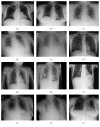Deep Convolutional Neural Networks for Chest Diseases Detection
- PMID: 30154989
- PMCID: PMC6093039
- DOI: 10.1155/2018/4168538
Deep Convolutional Neural Networks for Chest Diseases Detection
Abstract
Chest diseases are very serious health problems in the life of people. These diseases include chronic obstructive pulmonary disease, pneumonia, asthma, tuberculosis, and lung diseases. The timely diagnosis of chest diseases is very important. Many methods have been developed for this purpose. In this paper, we demonstrate the feasibility of classifying the chest pathologies in chest X-rays using conventional and deep learning approaches. In the paper, convolutional neural networks (CNNs) are presented for the diagnosis of chest diseases. The architecture of CNN and its design principle are presented. For comparative purpose, backpropagation neural networks (BPNNs) with supervised learning, competitive neural networks (CpNNs) with unsupervised learning are also constructed for diagnosis chest diseases. All the considered networks CNN, BPNN, and CpNN are trained and tested on the same chest X-ray database, and the performance of each network is discussed. Comparative results in terms of accuracy, error rate, and training time between the networks are presented.
Figures









References
-
- Er O., Yumusak N., Temurtas F. Chest diseases diagnosis using artificial neural networks. Expert Systems with Applications. 2010;37(12):7648–7655. doi: 10.1016/j.eswa.2010.04.078. - DOI
-
- Dos Santos A. M., Pereira B. B., de Seixas J. M. Neural networks: an application for predicting smear negative pulmonary tuberculosis. Proceedings of the Statistics in the Health Sciences; 2004; Liège, Belgium.
-
- Avni U., Greenspan H., Konen E., Sharon M., Goldberger J. X-ray categorization and retrieval on the organ and pathology level, using patch-based visual words. Proceedings of IEEE Transactions on Medical Imaging; 2011; Orlando, FL, USA. - PubMed
MeSH terms
LinkOut - more resources
Full Text Sources
Other Literature Sources

